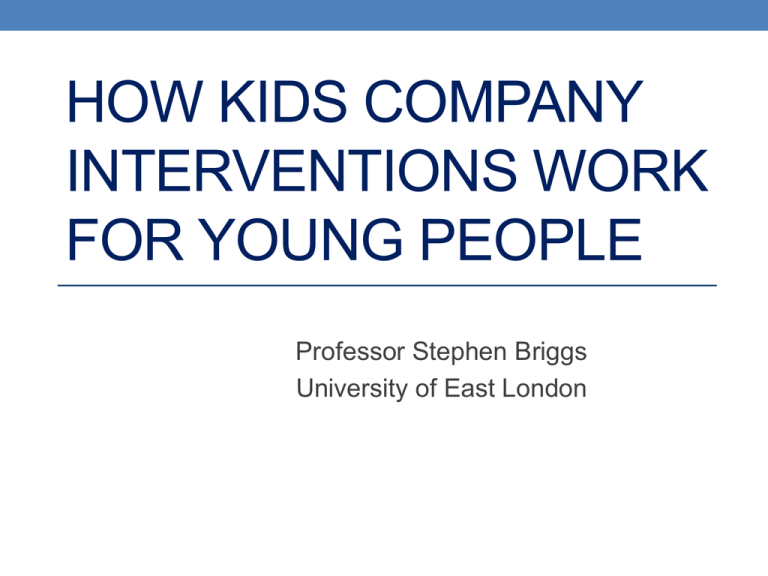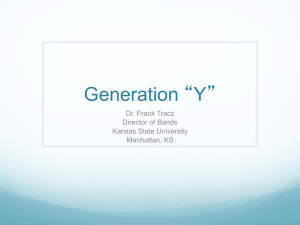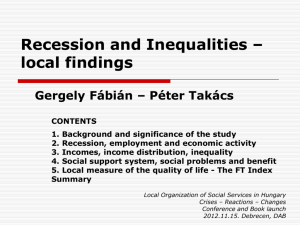PowerPoint
advertisement

HOW KIDS COMPANY INTERVENTIONS WORK FOR YOUNG PEOPLE Professor Stephen Briggs University of East London A QUALITATIVE EVALUATION OF KIDS COMPANY’S ‘LEGIT LIVING’ PROGRAMME Stephen Briggs, Hannah Linford, Lorraine Ainscow, Aayesha Mulla, Andrew Whittaker The Tavistock Clinic, UK with Stephen Briggs Consulting 2011- 2013 “I’ve matured quickly because of what happened in my life…. from age 4, I’ve been looking after my family… we didn’t really have that much food, clothes....we didn’t know when we was gonna eat, how long the food was gonna last” “I don’t like talking about stuff. I tend to bury it until I explode. I don’t want to talk to anyone…[but]......just stay in bed, hide away, hope it goes away”. “I didn’t know how to like talk to people” “Like if there weren’t organisations like Kids Company about I would have been terrorising the streets, literally like a menace to society….something I would not like to have become, but luckily I had Kids Company Aims and Methods • Aims: • to assess the outcomes for a sample of young people accessing Kids Company’s services • to assess the process of change through listening to young people reflecting on their experiences • to make a contribution to understanding how Kids Company interventions impact on the lives and issues facing young people • Methods • Qualitative longitudinal Interviewing (QLI) • Practice-near methods: • (Briggs and Froggett 2009; Froggett and Briggs 2012) Sample and data collection • Sample: • Young people (age 13-24 )were interviewed 3 times at 6 monthly intervals i.e. over a 12 month period • 29 young people at baseline, • 27 after 6 months and • 22 after (at least) 12 months • Data Collection • In depth qualitative interviews with young people • In depth interviews with 10 key workers • Case notes Data Analysis Narratives Profiles Case studies 22 participants interviewed at 6 monthly intervals Categories from interviews tabulated Structured accounts to illustrate journeys Focus on interactions/ Clustering by age group Initial assessment emotional qualities Backgrounds Issues at first interview Analysed using ‘practice near’ methods Outcomes assessed as both ‘hard’ and ‘soft’ categories Changes after 6 months Changes after 12 months Gains (positive outcomes) Current challenges Cluster Number of YPs completing the evaluation Number of YPs at baseline Under 16 4 4 16-19 5 7 19-22 7 9 22 and above 6 9 total 22 29 FINDINGS Background characteristics • Family backgrounds were traumatising through: • Abusive/neglecting/violent • Poverty/marginalisation • Disrupted/separated • Mental ill health • Substance abuse • criminality • Young people were • Marginalised • Enduring poverty • Educational failure • Mental and physical health problems • Engaged in risky/antisocial behaviours • Failed by societies support systems Baseline Characteristics “a grim picture was identified of the backgrounds and issues faced by these young people” • Cluster 1 (up to 16 years): • limited, neglectful and potentially abusing families impacting on development • Cluster 2 (16-19 years) • abusive and difficult family relationships precipitate young people to face these years outside their families • Clusters 3 and 4 (19-23/25 years) • These years are spent aiming to recover and repair earlier traumas and disadvantages whilst experiencing the challenges of young adulthood Their basic needs have not been met……. • Out of the 29 young people:• 17 had problems with sleeping • 13 had problems with eating • 25 had serious housing problem • of which 14 faced homelessness • 19 had involvement in crime and • 16 left school with no qualifications. ‘Sometimes I want to kill myself when I’m in my flat’ – no TV, no nothing’. “I was in a wave of crime, a wave of bullying, a wave of…..a lot of things which really made me an unhappy person. It’s the trauma I experienced as a young person and stuff that I saw which made me go into that stuff”. “I wasn’t getting on well with my school work, I kept having problems understanding what to do” (participant, 12 years) “I smile all the time” Kids Company Interventions “the comprehensiveness of the provision, the volume of work and the teamwork involved are key features” • Addressing trauma therapeutically to bring about healing and repair… • at the practical level, direct provision of food • • • • • • • (meals in the centres), food vouchers, money for travel, paying rent; support for accommodation, furnishings, decorating (‘Colour a Child’s Life’) advocacy and negotiation with housing, children’s services, UKBA classes for GCSE’s, bronze/silver/gold awards in dance, drama, art, photography, fashion activities for younger children in the centres mentoring and ‘positive experiences’ for school/college work, CVs, applications, work, apprenticeship applications, work placements physical fitness facilities camps and expeditions; shows therapies of various modalities and massage “I love my keyworker, she’s great” Keyworkers “If you genuinely need someone to talk to there’s someone here that will listen to you. No misconceptions, unlike other agencies. Unconditional attention, round the clock. There are no “empty promises” at Kids Company.” “The people here to support us are doing a terrific job like we may not act like it, but we are grateful no matter how much we swear at you, no matter how much we cuss at you. It all comes from a loving place” Outcomes reduced risks to personal safety increased stability in practical living (housing, finance, legal status) being in education and achieving educationally and/or in employment improvements in mental well-being, including selfesteem, self- confidence and reduced mental ill health reduction or cessation of offending behaviours raised aspirations (and working towards putting these into practice) improved interpersonal and familial relationships Summary of Outcomes • All young people made gains in some areas, increasing • • • • • achievement and reducing adversities Most continue to face challenges Positive outcomes (gains) outweighed continuing challenges for 13/22 Additionally, the in-depth working continually addresses new challenges as they occur Prevention of some potentially negative outcomes is not captured directly (e.g. prevention of family breakdown, school exclusion etc) ‘The Spiral of fluctuations’ Challenges Setbacks Interventions Improvements ‘It gives me pride to get (good grades at university). Is this really mine? I couldn’t believe it’. “you get to be yourself and just have fun and join with loads of different activities and meet new people and just express yourself and have fun” (11 year old about Kenbury) “…now and again I’ve got myself into little predicaments because obviously there’s still people around me….like a lot of my friends are still caught up in a lot of things so obviously I’m gonna be around certain situations. ……..Kids Company has just given me the knowledge to kind of see like you’ve got options, your choice if you wanna do it you do it, but you know there might be some unfortunate consequences” How do the interventions support better outcomes for young people? • The Kids Company relational/attachment/holistic approach: • Develops resilience to adversity • Provides social capital to assist the transition to adulthood • Supports investments in competences, aspirations and achievements Love + ‘agency’ = potential for change! “I decided I loved physical fitness more than I loved cannabis” Conclusions • The study used QLI methods to generate nuanced, • • • • • contextualised data about process and outcomes for a sample of kids This sample had extensive and serious experiences of abuse and deprivation in their childhood/adolescent years causing severe difficulties across all aspects of their development and functioning The holistic, ‘wrap around’ model of care fits the needs of these young people; the extent of their needs and the intensity of the input varies according to the extent of the prior deprivation and trauma All young people demonstrated improved outcomes (in 1 or more of the 6 key areas)l these are impressive for this sample The outcomes are subject to fluctuation rather than linear; setbacks generate new challenges The young people focussed on the relationships with Kids Company as central to their investments and improvements






